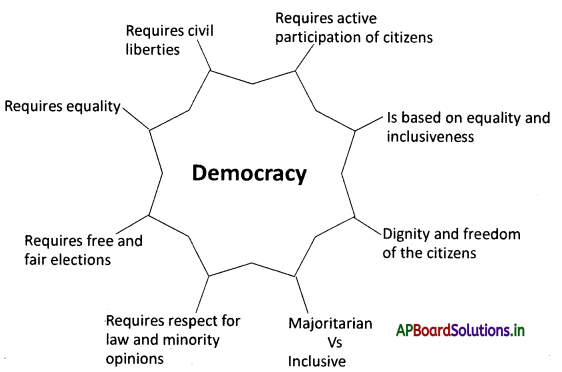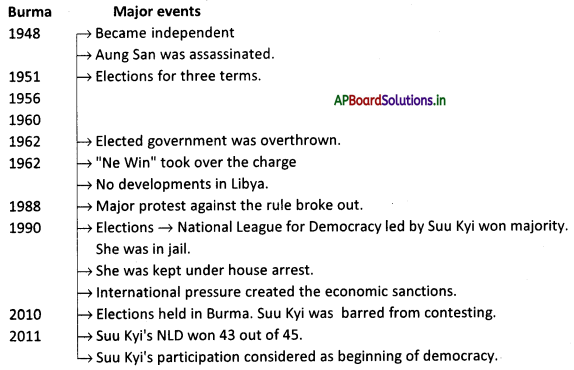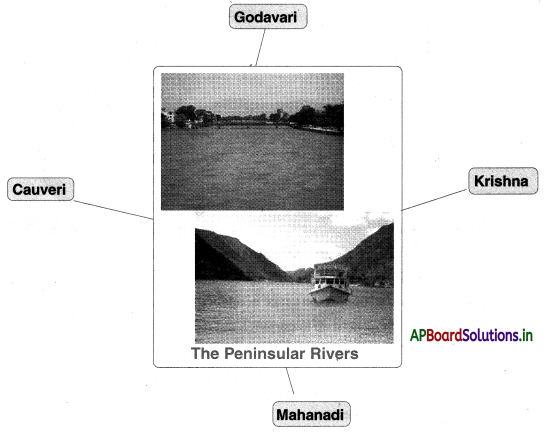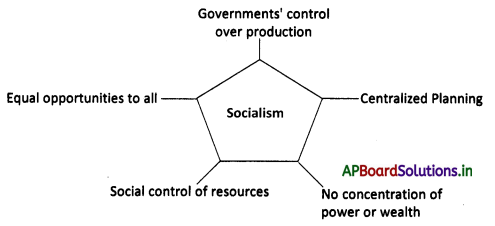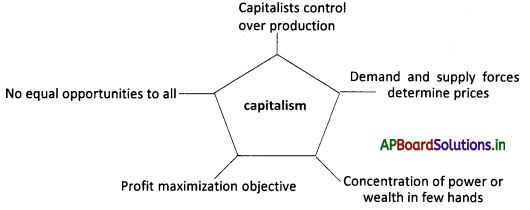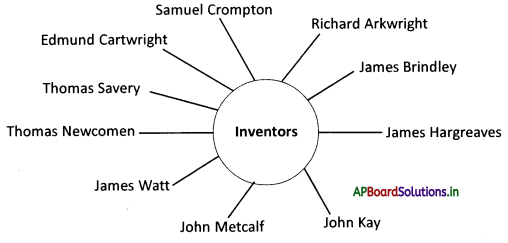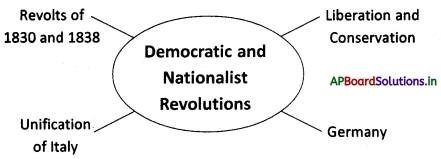Students can go through AP State Board 10th Class Biology Notes Chapter 4 Excretion to understand and remember the concept easily.
AP State Board Syllabus 10th Class Biology Notes Chapter 4 Excretion
→ Excretion is the term coined for all the biological processes involved in the separation and removal of wastes or non-useful products from the body.
→ The waste products include carbon dioxide, water, nitrogenous compounds like ammonia, urea, uric acid, bile pigments, excess salts, etc.
→ A human excretory system consisting of a pair of kidneys, a pair of ureters, urinary bladder, and urethra.
→ The kidney is bean-shaped from the inner side of each kidney, has fissure or hilus.
→ Through the hilus renal artery enters and the renal vein and ureter exit.
→ Each kidney is composed of a large number of uriniferous tubules or nephrons, which are structural and functional units of the kidney.
→ A nephron comprises Glomerulus, Bowman’s capsule, Proximal Convoluted Tubule (PCT), Distal Convoluted Tubule (DCT), and collecting tubule.
→ Urine formation occurs in four stages: They are
- Glomerular filtration,
- Tubular reabsorption,
- Tubular secretion and
- The concentration of urine.
→ Glomerulus filtrate is also called primary urine.
→ Primary urine is almost equal to blood in chemical composition except for the presence of blood cells.
→ Useful substances in primary urine are reabsorbed into the peritubular network.
→ In tubular secretion, some other wastes like extra salts, ions of K+, Na+, Cl– and H+ secretes from peritubular capillaries into the distal convoluted tubules.
→ 75% of the water content of the nephric filtrate is reabsorbed in the region of the proximal convoluted tubule.
→ Kidneys remove nitrogenous waste from the body, maintains water balance (osmoregulation), salt content, pH, and blood pressure in the human body.
→ The concentration of urine takes place in the area of collecting tubes in the presence of a hormone called vasopressin.

→ The absence of vasopressin hormone produces dilute urine.
→ The movement of urine in the ureter is through peristalsis.
→ The urinary bladder opens into the urethra which is 4 cm long in females and about 20 cm long in males.
→ The urethra’s opening is separate in females but is in common with the reproductive tract in males (urinogenital duct).
→ The discharge of urine from the body is called micturition.
→ Urine has amber color due to the presence of urochrome.
→ Urine contains 96% of water, 2.5% of organic substances, and 1.5% of inorganic solutes.
→ Complete and irreversible kidney failure is called ‘End-Stage Renal Disease’ (ESRD).
→ Uremia is the condition in which kidneys stop working completely and it results in a body being filled with extra water and waste products.
→ The dialysis machine is used to filter the blood of a person whose kidneys are damaged. The process is called ‘hemodialysis.’
→ Kidney transplantation is a permanent solution for renal failure patients.
→ The process of transplantation of organs from brain-dead patients to another is called ‘cadaver transplantation.’
→ The first kidney transplantation was performed by Dr. Charles Hufnagel in Washington, the USA in 1954.
→ In India, the first kidney transplantation was done on 1st December 1971 at the Christian Medical College, Vellore, Tamilnadu.

→ Lungs, skin, liver have their own specific functions but carry out excretion as a secondary function.
→ Different animals have different excretory organs.
- Eg. amoeba and paramoecium – contractile vacuole.
- Phylum Excretory organs and systems.
- Platyhelminthes: Flame cells
- Annelids: Nephridia
- Arthropoda: Green glands, Malpighian tubules
- Mollusca: Meta nephridia
- Echinodermata: Water vascular system
- Reptiles, Birds, and Mammals: Kidneys
- Porifera, coelenterates: Water bathes almost all their cells
- Protozoa: Simple diffusion from the body surface into the surrounding water.
→ In plants, there are no specific organs to excrete wastes.
→ Plants can get rid of excess water by a process like transpiration and guttation.
→ In plants, waste products may be stored in leaves, bark, and fruits.
→ Waste gets stored in the fruits in the form of solid bodies called Raphides.
→ The biochemical substances produced in plants are of two types, primary metabolites, and secondary metabolites.
→ Carbohydrates, fats, and proteins are primary metabolites.
→ Alkaloids, Tannins, Resins, Gums, and Latex, etc., are called secondary metabolites which do not require normal growth and development.
→ Alkaloids are nitrogenous by-products and poisonous.
→ Tannins are carbon compounds used in the leather industry and medicines.
Eg.: Cassia, Acacia.
→ Resin occurs mostly in Gymnosperms in specialized resin passages. They are used in varnishes.
→ Gum is a sticky substance that comes out when branches are cut in plants like Neem, Acacia.

→ Latex is a sticky, milky white substance secreted by plants.
→ From the latex of Heaven, Braziliensis rubber is prepared and from the latex of jatropha, bio-diesel is prepared.
→ Excretion is the removal of material from a living being, whereas secretion is the movement of materials from one point to another points.
→ Creatine: Nitrogenous organic acid occurs naturally in vertebrates, helps to supply energy to all cells in the body primarily muscles. This is achieved by increasing the formation of AiR
→ Tubular fluid: The filtered out fluid from the glomerulus contains waste molecules, nutrient molecules, and water. From the glomerulus, this fluid enters the tubular portion of the nephron.
→ Perftubular: Around the tubes, the renal tubule of nephrons ¡s surrounded by peritubular capillaries formed from an efferent arteriole.
→ Podocyte: These are single-layered squamous epithelial cells lining the glomerulus. The fine pores present between podocyte cells allows the passage of materials filtered out of the glomerulus.
→ Hyper – osmotIc: It ¡s more concentrated with solutes and has a higher osmotic pressure than blood plasma. This solution bathes and surrounds Interstitial fluids the cells of multicellular animals.
→ Glomerulus: It is a bunch of fine blood capillaries developed from an afferent arteriole. The blood ¡s filtered through the capillaries of the glomerulus into Bowman’s capsule.
→ PCT (Proximal Convoluted Tubule): It is the first part of the renal tubule of Nephron that starts from Bowman’s capsule. Useful substances in primary urine are reabsorbed into the peritubular network.
→ DCI’ (Distal Convoluted Tubule): It s the last part of the renal tubule of Nephron. In DCT some other wastes like extra salts, ions of K+, Na+, Cl– and H+ are secreted from peritubular capillaries into DCT.

→ Afferent Arteriole: It forms a capillary network called glomerulus inside the Bowman’s capsule. It brings the pressured blood to the glomerulus and the pressure produces the flow of plasma fluids into the tubule.
→ Efferent ArterIole: ft is formed from Afferent arteriole. They play an important role in maintaining the glomerular filtration rate.
→ Calyces: Renal calyces are parts of the kidney that collect urine before it passes further into the urinary tract. These are the parts of the renal pelvis.
→ Micturition: It is the discharge of urine.
→ Urochrome: It is a pigment that causes the yellow color in urine. It is a breakdown product of the blood’s hemoglobin and is removed by the kidneys.
→ Henle’s loop: It is the portion of the nephron that leads from the proximal convoluted tubule to the distal convoluted tubule. It is named after its discoverer a German Anatomist Friedrich Gustav, Jakob Henle. Its main function is to create a concentration gradian in the medulla of the kidney.
→ Dialyzer: A medical instrument for separating substances in solution by unequal diffusion through a semi-permeable membrane.
→ Hemodialysis: It is the process of filtering the blood of a person by using a dialysis machine.
→ Anticoagulant: It does not allow the blood to clot. Eg. Heparin.
→ Alkaloid: Alkaloids are nitrogenous by-products and poisonous which are stored in different parts of the plant.
→ Biodiesel: The fuel which is obtained from biological materials of plants and animals.

→ Excretion: It is a biological process involved in the separation and removal of wastes or non-useful products from the body.
→ Michigan body: It ¡s the first part of Nephron. It consists of a blind cup-shaped broader end of the nephron called Bowman’s capsule and glomerulus.
→ Specimen: An individual animal, a plant, piece of mineral, etc., used as an example of its species or type for scientific study or display.
→ Hilus: The inner side opening of the kidney through which renal artery enters and exits of renal vein and the ureter.
→ Ureters: A pair of whitish, narrow stretch and expandable muscular tubes of 30 cm length arise from the hilus of the kidneys.
→ Cortex: Dark-colored outer zone of the kidney.
→ Medulla: Pale-colored inner zone of the kidney.
→ Nephron: It is also called a uriniferous tubule. It is the basic structural and functional unit of the kidney. It filters the blood, reabsorbs and what is needed, and excretes what is not needed as urine.
→ Bowman’s capsule: It is the cup-shaped broader end of the nephron.
→ PelvIs: It is a funnel-like dilated proximal part of the ureter in the kidney. It is the point of convergence of two or three major calyces.
→ Distensible: Able to stretch and expand.
→ Peristalsis: The involuntary wave-like muscular movement in the alimentary canal or ureter.
→ Sphincter: A ring of muscle that contracts to close an opening.
→ Urethra: It is a tube that takes urine from the urinary bladder to the outside.
→ Amber color: It is a pure chroma color, located on the color wheel midway between yellow and orange.
→ Dialysis: The chemical bath used in dialysis to draw toxins out of the bloodstream and supply electrolytes and other chemicals to the bloodstream.

→ Transplantation: An operation moving an organ from one organism to another.
→ Immune system: It ¡s a network of cells, tissues, and organs that work together to defend the body against attack by foreign invaders.
→ Braindead: It is the irreversible end of brain activity. Patients classified as brain dead can have their organs surgically removed for organ donation.
→ Contradilve vacuoles: It is a subcellular structure involved in osmoregulation. It’s are found predominantly in protists and in unicellular algae.
→ Guttation: The secretion of droplets of water from the pores of plants.
→ Yam: The edible starchy tuber of a climbing plant widely distributed in tropical and subtropical countries. (Pendulum in Telugu)
→ Chicle: It Is a natural gum traditionally used in making chewing gum and other products. It is collected from several species of Meso-American trees.
→ Alkaloid: These are nitrogenous by-products and poisonous. These are stored in different parts of the plants.

→ Osmoregulation: The process of regulating water contents and ion concentration in the body is called osmoregulation.

→ William John Kolff (1911 – 2009):
- William John Kolif invented the first practical artificial kidney in 1947.
- He was a pioneer of Haemodialysis as well as in the field of artificial organs.
- He constructed a dialysis machine with which filtered the blood artificially.
- The machine works on simple principles of diffusion and filtration across a semipermeable membrane.
![]()
![]()
